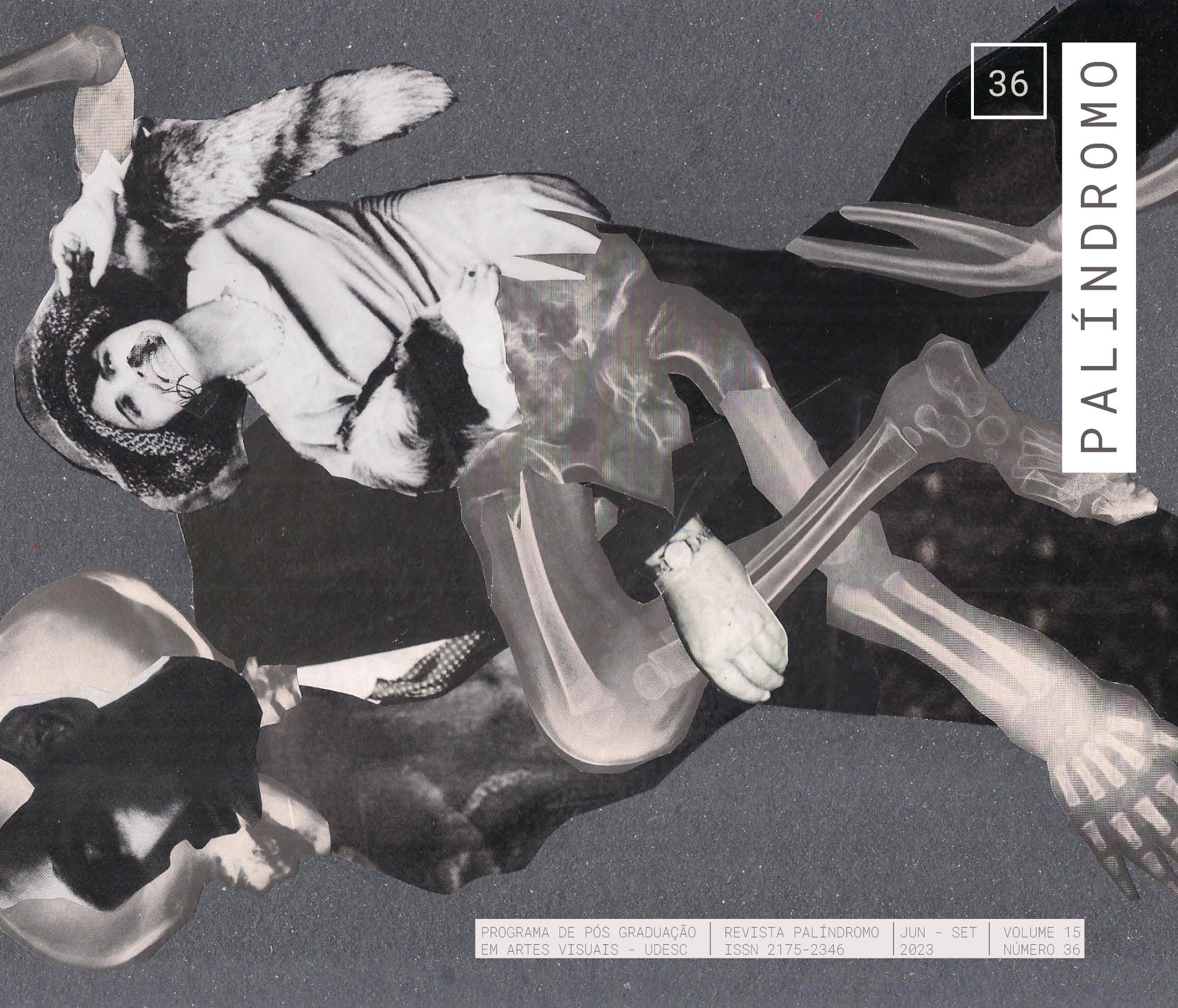The grotesque at Panel 32 of Atlas Mnemosyne
DOI:
https://doi.org/10.5965/2175234615362023e0006Keywords:
Atlas Mnemosyne, Aby Warburg, Panel 32 of Atlas Mnemosyne, grotesqueAbstract
The category of grotesque is addressed through the analysis of panel 32 of Atlas Mnemosyne by Aby Warburg. The panel contains mainly Renaissance images, approaching themes that span the ages since Antiquity, such as the dance of the moresca, the amorous courtship and the cult of the goddess Venus, the pictorial genre of Singeries (monkeys) and the battle for the trousers. A panel solely dedicate to the grotesque affirms the vigor of this aesthetic category. Together with the analysis of the images, we presente definitions and reflections on the grotesque as approached by André Chastel, Wolfgang Kayser, and, mainly in Victor Hugo. For the French wiriter, the grotesque form is opposed to the classic and exists in nature and not world around us, even if in a kaleidoscope of (in)definitions. Other aesthetic categories are approached in parallel, such as the beauty, for which the grotesque appears as a contrast; the comic; the ugly, with its contrasting diversity to the unity of beauty. The images selected by Warburg pervade such theoretical reflections and reveal fundamental polarities to understand the expression of human commotions: Dionysian-Apollinae, madness-reason, animal-human, liberation-domestication, chaos-order, pathos-logos, distancing-immersion, energetic expansion – energy containment. This article also tries to understand a method in Aby Warburg, whether in the selection and organization of images on the panel; it shows Warburg thematic interests, in this case, festivals and popular traditions; and also, his interest in the dissonant, beyond reductionist generalizations and art history's canonical objects.
Downloads
References
BAXANDALL, Michael. The Limewood Sculptors of Renaissance Germany. New Haven/London: Yale University Press, 1981.
BOGERS, J. The Battle between Carnival and Lent (2010). Disponível em: https://www.rijksmuseum.nl/en/collection/SK-A-1673/catalogue-entry?pdfView=False Disponível em: 29 mar. 2023.
CASSIRER, E. Epitáfio a Aby Warburg (1929).Tradução de I.C. Fragelli. In: Discurso,46(1), p. 271-282, 2016. Disponível em: https://doi.org/10.11606/issn.2318-8863.discurso.2016.119172 Acesso em:10 fev.2023
CASTIGLIONE, Baldesar. O livro do cortesão. Porto: Campo das Letras, 2008.
CENTANNI, Monica; MAZZUCCO, Katia. Introduction to Mnemosyne Atlas Panels. Engramma, n. 1, set. 2000. Disponível em: http://www.engramma.it/eOS/index.php?id_articolo=4891 Acesso em 29 mar. 2023.
CHASTEL, André. La grottesca. Milano: Abscondita, 2010. (Originalmente 1991)
ECO, Umberto. História da feiura. Rio de Janeiro: Record, 2015.
GINZBURG, Carlo. Mitos, emblemas, sinais: morfologia e história. São Paulo: Companhia das Letras, 1990.
HALL, James. Dictionary of Symbols and Subjects in Art. New York: Harper & Row, 1979.
HUGO, Victor. Do grotesco e do sublime (Prefácio de Cromwell). Trad. Celia Berretini. São Paulo: Perspectiva, 2014.
KAYSER, Wolfgang. O grotesco. São Paulo: Perspectiva, 2013.MEDEIROS, Afonso; PEREIRA, Marcos Villela. Chamada de artigos para o Dossiê número 36 da Revista Palíndromo: As artimanhas do grotesco no contemporâneo. 2022. Disponível em < https://www.revistas.udesc.br/index.php/palindromo/announcement/view/457> Acesso em 10 jan.2023.
MNEMOSYNE, Seminario. Il Laocoonte: desiderio di una formula patetica antica e fortuna del soggetto Letture grafiche di Mnemosyne Atlas, Tavola 41a. Engramma, 25, mag.-giug. 2003. Disponível em: http://www.engramma.it/eOS/index.php?id_articolo=3694 Acesso em 24 mar. 2023.
MNEMOSYNE ATLAS 32. Disponível em: http://www.engramma.it/eOS/core/frontend/eos_atlas_index.php?id_tavola=1032 Acesso em 24 fev. 2023.
NUTTALL, Paula. Low life, high Society: a group of comic-grotesque drawings by Verrocchio. Renaissance Studies, v. 35, n. 2. pp. 287-317, apr. 2021.
SODRÉ, Muniz; PAIVA, Raquel. O império do grotesco. Rio de Janeiro: Mauad, 2014.
VASARI, Giorgio. Vidas dos artistas. São Paulo: Martins Fontes, 2011.
VÁZQUEZ, Adolfo. S. Um convite à estética. Trad.: Gilson Baptista Soares. Rio de Janeiro: Civilização Brasileira, 1999.
THE MORRIS DANCERS. Münchner Stadtmuseum. Disponível em: https://www.muenchner-stadtmuseum.de/en/collections/applied-arts-collection/the-morris-dancers#:~:text=Made%20by%20the%20sculptor%20Erasmus,at%20the%20major%20European%20courts. Acesso em 25 mar. 2023.
TIBERINI, Elvira Stefania. La moresca: aspetti sociocultural di uma danza Popolare tradizionale in ter diversi contesti etnografici. L’Uomo, v. 2, n. 2. pp.193-213, 1982.
WARBURG, Aby. Atlas Mnemosyne. Paris: l’Écarquillé, 2012.
WARBURG, Aby. A arte italiana e a astrologia internacional no Palazzo Schifanoia, em Ferrara. In: A Renovação da Antiguidade pagã: Contribuições científico-culturais para a história do Renascimento europeu. Rio de Janeiro: Contraponto, 2013a. p. 453-506.
WARBURG, Aby. O nascimento de Vênus e A primavera de Sandro Botticelli (1893). In: A Renovação da Antiguidade pagã: Contribuições científico-culturais para a história do Renascimento europeu. Rio de Janeiro: Contraponto, 2013b. p. 3-88.
WARBURG, Aby. Os figurinos teatrais para os intermezzi de 1589 (1895). In: A Renovação da Antiguidade pagã: Contribuições científico-culturais para a história do Renascimento europeu. Rio de Janeiro: Contraponto, 2013c. p. 339-426.
WARBURG, A. Dürer e a Antiguidade italiana (1905). In: A Renovação da
Antiguidade Pagã: Contribuições científico-culturais para a história do Renascimento europeu.. Rio de Janeiro: Contraponto, 2013d. p. 435-445.
WARBURG, Aby. Introdução à Mnemosine. In: Histórias de fantasma para gente grande. São Paulo: Companhia das Letras, 2015. p. 363-375.
WARBURG, Aby. Bilderatlas Mnemosyne: The Original. Berlin: Hatje Cantz, 2020.
WEDEKIN, Luana. No caminhar da ninfa: processos de potencialização e domesticação da imagem em Warburg e Panofsky. In: 27o Encontro da Associação Nacional de Pesquisadores em Artes Plásticas, 2018, São Paulo. Práticas e ConfrontAÇÕES Anais [recurso eletrônico] do 27o Encontro da Associação Nacional de Pesquisadores em Artes Plásticas, setembro de 2018, São Paulo, SP. São Paulo: ANPAP/UNESP, 2018. v. 1. p. 1931-1946.
Downloads
Published
How to Cite
Issue
Section
License
Copyright (c) 2023 Sandra Makowiecky, Luana Maribele Wedekin

This work is licensed under a Creative Commons Attribution 4.0 International License.
COPYRIGHT STATEMENT
The articles published by the magazine are free to use, intended for academic and non-commercial applications. Copyright is all assigned to the magazine. The articles whose authors are identified represent the expression from the point of view of their authors and not the official position of Palíndromo Magazine. The author (s) commits to whenever they publish material referring to the article published in Palíndromo mention this publication as follows:
This article was originally published by Palíndromo magazine in its volume (place the volume), number (place the number) in the year of (place the year) and can be accessed at: http://www.revistas.udesc.br/index.php/palindromo


